Reminiscences of a Raleigh Boy, Part 4: The Warehouse District
Like a Phoenix from the Ashes: Raleigh’s Downtown Warehouse District
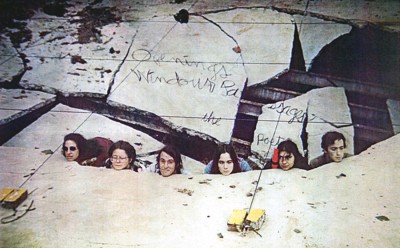
From left to right: Julia Demarre, Allyn Stewart, Avi Wenger (author of the performance), Katherine Myers, Ronnie Ruedrich, and David Sedaris
The cast of “Openings Windows and Passages” peering up from the floor of Lot 13 in this promo shot by Mark Herdter in 1979.
Just as Raleigh’s Fayetteville Street is currently undergoing a Renaissance, likewise is the city’s old industrial warehouse district located between downtown and the railroad tracks. New housing units intermingle with nightclubs; lofts are filling long empty warehouse spaces; and it is emerging as a focus of downtown nightlife. The warehouse district is awaking from the long slumber it had fallen into after the hustle and bustle of its industrial glory days had faded.

The freight depot between Cabarrus and Davie in 1971.
For more than half a century, and well into the 1950s, the warehouse district bustled with activity. It was the home of many rail-dependent industries such as machine shops, foundries, ice plants, coal yards, oil and feed mills, and bottling plants. And of course, there were the warehouses — dozens of them!
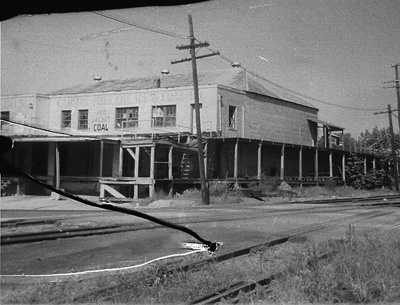
This is the old Capital City Ice and Coal plant at the corner of W. Hargett and the train tracks.
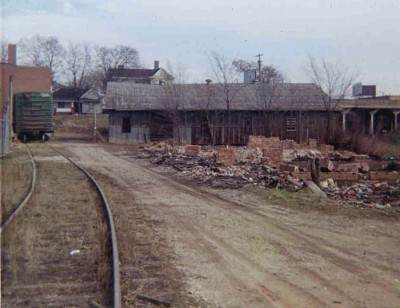
This is a view of the warehouses behind the ice plant being torn down in 1972.
When I was a freshman at N.C. State in 1970, I moved into my first apartment in the old Page House in Boylan Heights. If I needed to go downtown for anything, I made my way along the Martin Street viaduct. The bridge spanned the tracks and rail yards from Boylan Avenue to West Street, and deposited you right into the middle of the warehouse district.
By that time, Dillon Supply and Peden Steel dominated the area. Their massive brick buildings exuded a lonely drabness, which in my young mind I associated with the Soviet Union. It wasn’t a place you wanted to linger, and certainly not to pass through at night.
Nevertheless, it wasn’t long before I was beguiled by the rail yards, empty buildings and architectural curiosities. With my trusty Instamatic Kodak in tow, I set out to explore the area. I explored a long-closed ice plant and the adjoining frame and brick warehouses, and investigated the underground chambers of a burned out Civil War era warehouse. I discovered a “secret†entrance to the catacombs beneath the old Coca Cola bottling plant and, accompanied by a friend, explored that dark and scary place. For just plain fun we would sometimes hop a slow-moving string of railcars for a short trip through the switching yard.
This is how the Martin Street viaduct looked in 1971. It was originally built in 1913.
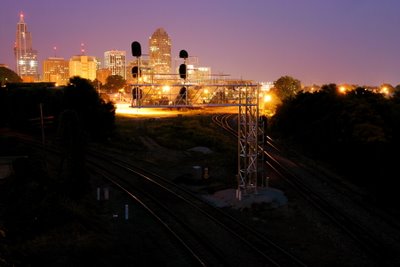
This is the 2008 view. The viaduct is no more, but notice how much the skyline has changed!
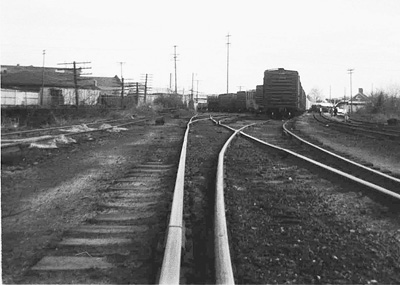
Part of the train switching yard with some of the warehouses surrounding Lot 13 on the left.

Raleigh’s Contemporary Art Museum at night– CAM
Long before CAM came onto the scene, the warehouse district was a magnet for many of Raleigh’s artists and designers. At least by the late ‘70s, the area was attracting the avant garde art crowd and artistic endeavors such as performances and installations were experimented with.
One of the sites used was the Civil War era warehouse lot. Only two walls were then standing above ground level and the exposed concrete floor. This site re-emerged as Lot 13. Beginning in 1978, a series of installations were created there.
One of these involved fabricating a mock steel truss modeled after that of the old Boylan Ave. bridge, which was within sight of Lot 13. It was constructed of black-painted 2×4s mounted high up on the wall, and was visible from the bridge itself. The truss remained there for many years afterward.
In 1979 in an empty warehouse adjacent to Lot 13, another artist friend staged a performance piece he called “Openings Windows and Passages.†Among the troupe was a young David Sedaris, now author extraordinaire.
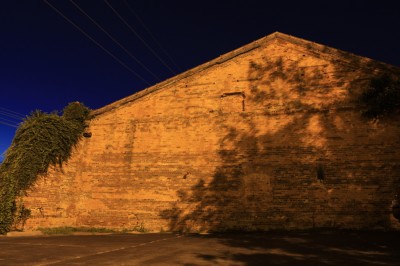
This is a night time view of the only remaining portion of the Civil War era warehouse, aka lot 13.
The early 1980s saw the William-Cozart woodshop and sales gallery on S. Harrington Street, and Anthony Ulinski’s Dovetail fine woodwork on Commerce Street enter the scene. Both are still in their original locations.
John Dancy-Jones relocated his Paper Plant bookstore to W. Martin Street in 1985. It was a popular venue among the Raleigh art crowd of the time and featured Thursday night poetry readings, among other events. John invited artists to show their work in the Paper Plant gallery, and the associated Sunday afternoon receptions soon became a popular mainstay.
I remember two events at the Paper Plant that stand out in particular: One was an installation created by artist Ron Ridgeway called The Buddah Wall; the other was a performance piece by Clyde Smith and Ginny Webb.
Way in the back of the Paper Plant was a dark and windowless room, on the walls of which Ron painted hundreds of small Buddah figures. Lit by candlelight, the effect was rather eerie. I wonder if it is still there today.
The performance piece was acted out in the front window of the shop. I don’t remember too many details of the piece itself, but I’ll never forget the look on John’s face as he contemplated the real possibility of the two performers crashing through the plate glass window!Â
Photographer Doug Van de Zande opened his studio next door to the Paper Plant about 1987. He was renowned not only for his artistic photographs, but for his annual Halloween bashes, as well. His studio is still in the warehouse district, having moved over to S. McDowell Street 10 or so years ago. Thomas Sayre established his sculpture studio above the Paper Plant by the late 1980s, and was soon joined by architect Steve Schuster.
Bill Hickman ran his metal sculpture studio out of a warehouse on S. West Street for a number of years in the early ’90s. Fine artist Nancy Baker operated the Tire Shop Gallery and studio on S. Dawson from the mid to late ’90s. And architect Kurt Eichenberger opened his business in a remaining section of the old Allen Foundry complex about this time, too.
These days the warehouse district is becoming known as a burgeoning urban nightclub scene. Ever since a low-end live music venue, the Embers Club on W. Davie Street burned down in 1970, the area had been devoid of any nightlife at all. Then the The Berkeley opened on W. Martin in the mid ‘80s. To quote a friend: The Berkeley “absolutely pioneered alternative culture in 1980s downtown Raleigh.”
Around this time, too, the granddaddy of Raleigh’s gay clubs, The Capital Corral (aka C.C.s) opened its doors. On the fringe of the warehouse district were the short-lived Culture Club on W. Morgan and the raucous Fallout Shelter (aka the Fall Down Shelter) on S. West.
So, what goes around comes around, I guess. And although its glory days as a zone of industrial activity are no more, the warehouse district is certainly rising from those ashes as a center of downtown Raleigh’s arts and club scene — not without thanks to those early visionary urban pioneers who were willing to take a chance.

300 block of W. Martin St. in 1973. The Paper Plant later occupied the storefront in the left center of this view.
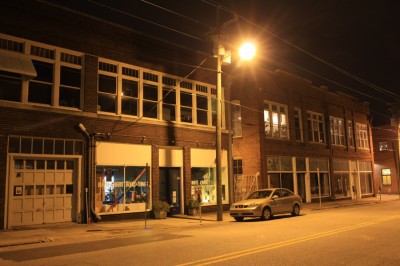
Same view a few nights ago. Not much has changed, has it?

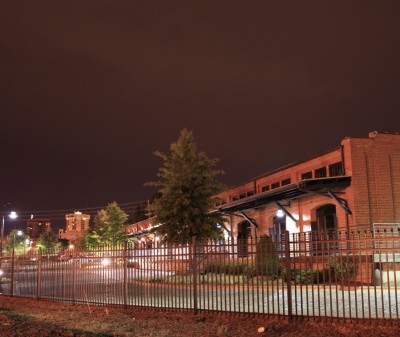
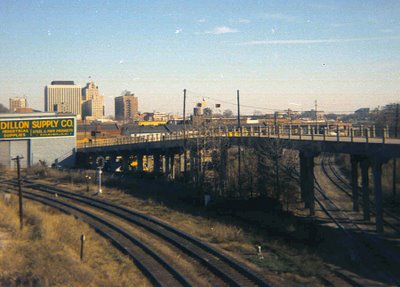
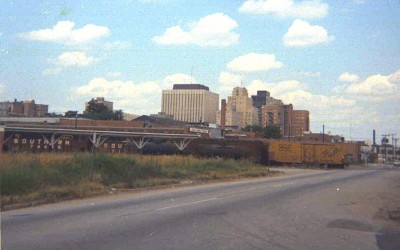
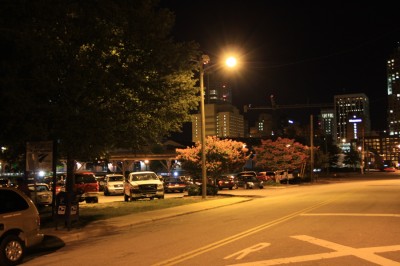
 Sign up for the Newsletter
Sign up for the Newsletter
05/24/2020
When I was at NCSU, we made weekly visits to a club downtown. Live bands every week… learned how to tighten-up with Archie Bell & the Drells in 1975. Please help me remember the name of this nightclub-we near St. Mary’s College.
08/03/2020
I have since discovered that the nightclub I was referring to was “The Showcase.” Also nearby was “The Other Eye.” Great times in the mid-seventies at these great nightclubs!